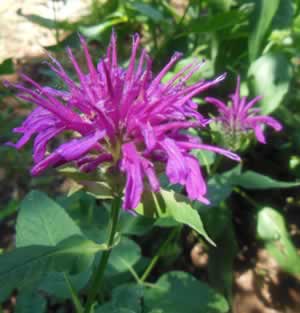Bee Balm Monarda didyma

Wild bergamot
- Common Names
- Bee Balm, Wild Bergamot , Scarlet Monarda, Oswego Tea, Bergamot, Horsebalm
- Botanical Name
- Monarda didyma
- Family
- LAMIACEAE
Medicinal Uses & Benefits of Bee Balm, Wild Bergamot
![]() How to Use|
Side Effects |
Plant & Garden|
Folklore
How to Use|
Side Effects |
Plant & Garden|
Folklore
- Medicinal Uses: * Culinary/Kitchen
* Herbal Teas
- Properties: * Analgesic * Antibacterial * Antifungal * Antioxidant * Carminative * Emmenagogue
- Parts Used: leaves, aerial plant
- Constituents: thymol, carvacrol, rosemarnic acid
How to Use: Bee Balm
Colonists brewed a black tea from Mondara and named it Oswego, perhaps after the Native American town where they first found it growing. They used it to relieve colic, fevers and colds, and the lemon scented oil was used to scent soaps. Both useful and pretty, bee balm soon became an early garden favorite. Today bee balm continues to be a most useful herb to use in both animals and humans. Like most mints, bee balm has a special affinity towards the digestive tract. Bee balm has excellent antibacterial qualities that make it useful for treating infections. So all told Bee balm tea is really good for you but I must confess that the reason I drink it all summer long is for the spicy, sweet taste.
Preparation Methods & Dosage :The fresh or dried leaf, stem and flowers can be made into an alcohol or glycerin tincture. The dried plant can be infused and made into skin and eyewashes, and herb teas.
Bee Balm Remedies
 In the Kitchen: The colorful blossoms have a strong minty flavor and best used sparingly. Separate the petals from the main head to scatter over fruit salads for an edible garnish.
In the Kitchen: The colorful blossoms have a strong minty flavor and best used sparingly. Separate the petals from the main head to scatter over fruit salads for an edible garnish.
Bee Balm Side Effects: None noted.
Plant Description

- Flowers:Scarlet, clustered in a solitary, terminal, rounded head of dark-red calices, with leafy bracts below it. Calyx narrow, tubular, sharply 5-toothed; corolla tubular, widest at the mouth, 2 lipped. 2 long anther-bearing stamens ascending, protruding, 1 pistil; the style 2-cleft.
- Stem:2 to 3 feet tall
- Leaves:Aromatic, opposite, dark green, oval to oblong lanceshaped, sharply saw-edged, often hairy beneathe, petioled;upper leaves and bracts often red.
- Preferred Habitat:Moist soil, especially near streams, in hilly or mountainous regions.
- Flowering Season:July - September
- Distribution:Canada to Georgia, west to Michigan.
Gorgeous, glowing scarlet heads of Bee Balm arrest, the dullest eye, bracts and upper leaves often taking on blood-red color, too, as if it had dripped from the lacerated flowers. Where their vivid doubles are reflected in a shadowy mountain stream, not even the Cardinal Flower is more strikingly beautiful. Thrifty clumps transplanted from Nature's garden will spread about ours and add a splendor like the flowers of salvia, next of kin, if only the roots get a frequent soaking. With even longer flower tubes than the Wild Bergamot's the Bee Balm belies its name, for, however frequently bees may come about for nectar when it rises high, only long-tongued bumblebees could get enough to compensate for their trouble. Butterflies, which suck with their wings in motion, plumb the depths. The ruby-throated humming bird - to which the Brazilian salvia of our gardens has adapted itself - flashes about these whorls of Indian plumes just as frequently - of course transferring pollen on his needle-like bill as he darts from flower to flower. Even the protruding stamens and pistil take on the prevailing hue.
Wild Bergamot Monarda fistulosa- Flowers:Extremely variable, purplish lavender, magenta, rose, pink, yellowish pink, or whitish, dotted; clustered in a solitary, nearly flat terminal head. Calyx tubular, narrow, 5-toothed, very hairy within. Corolla 1 to 1/2 in. long, tubular, 2-lipped, upper lip erect, toothed; lower lip spreading, 3-lobed, middle lobe longest; 2 anther-bearing stamens protruding; 1 pistil; the style 2-lobed.
- Stem:2 to 3 ft. high, rough, branched
- Leaves:Opposite, lance-shaped, saw-edged, on slender petioles; aromatic; bracts and upper leaves whitish or the color of flower.
- Fruit:
- Preferred Habitat:Open woods, thickets, dry rocky hills
- Flowering Season:June - September
- Distribution:Eastern Canada and Maine, westward to Minnesota, south to Gulf of Mexico.
Regional Traditions :North America *
How to Grow Bee Balm
Widely available but often overlooked by herbalists, this species of mint has an aromatic order similar to the citrus Orange Bergamot, but the two are not related. Indigenous to North America, and a garden favorite, the whole plant is strongly fragrant, even when dried. The strong but pleasant odor ranges from sweetly sage-like to a wild oregano scent.
Related Species
Monarda austromontana
Monarda citriodora
Monarda fistulosaWild Bergamot










